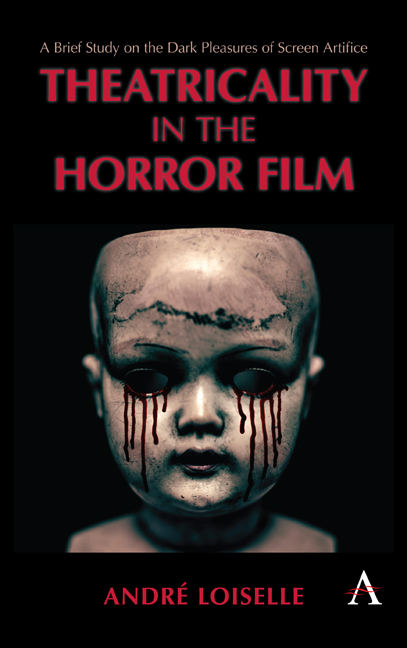Book contents
- Frontmatter
- Contents
- List of Illustrations
- 1 Introduction: Of Monsters and Monstration
- 2 Horror, Realism and Theatricality
- 3 The Theatricality of Monstrous Villainy in Film Adaptations of Horror Plays
- 4 The Theater as Locus Horribilis: Staging the Paradox of Tragic Horror
- 5 The Theatricality of Horror: Characters, Unities and Styles
- 6 Conclusion: The Theatricality of Horror Spectatorship
- Bibliography
- Index
3 - The Theatricality of Monstrous Villainy in Film Adaptations of Horror Plays
Published online by Cambridge University Press: 16 November 2019
- Frontmatter
- Contents
- List of Illustrations
- 1 Introduction: Of Monsters and Monstration
- 2 Horror, Realism and Theatricality
- 3 The Theatricality of Monstrous Villainy in Film Adaptations of Horror Plays
- 4 The Theater as Locus Horribilis: Staging the Paradox of Tragic Horror
- 5 The Theatricality of Horror: Characters, Unities and Styles
- 6 Conclusion: The Theatricality of Horror Spectatorship
- Bibliography
- Index
Summary
Leatherface, Jason Voorhees and Freddy Krueger are some of the more obvious examples of how the monstrous figure creates a sense of dread through the theatricality of over- the- top performance. Famously at the end of the original Texas Chain Saw Massacre (1974, Tobe Hooper), in what James Rose has called one of the most powerful images in the history of horror cinema (Rose 2014, 86), Leatherface (Gunnar Hansen) engages in a grotesque dance, wielding his bloody chain saw as he mesmerizingly spins around in the sun, performing a ghastly choreography of melodramatic horror. This is a moment of pure cinematic theatricality, where the monstrous figure's bizarre performance clashes with the gritty realism of Sally's (Marilyn Burns) escape in the back of an old pick- up truck. Similarly, Jason's spectacular brutality always includes a strong element of theatricality. This is especially obvious in Friday the 13th, Part III (1982, Steve Miner), where the masked killer's (Richard Brooker) propensity for violently crashing through doors, ferociously tearing off limbs, savagely impaling torsos and crushing skulls is augmented by 3D special effects. Theatricality is even more self- consciously manifest in Wes Craven's New Nightmare (1994, Wes Craven), the seventh and most self- referential installment in the Nightmare on Elm Street franchise. Here, Heather Langenkamp, the actor playing Nancy the Final Girl in the original Nightmare on Elm Street (1984), and Wes Craven appear as themselves having to battle Freddy, who has now managed to enter the “real world.” Early in the film, Robert Englund playing himself playing Freddy Krueger makes an appearance on a talk show, outrageously hamming it up for the fans in the audience. Englund/ Freddy'sghoulish histrionics captivate the spectators within the film, thus attesting to Craven's understanding of the role of performance in the construction of monstrosity (Figure 3.1).
A few scholars have paid attention to the question of how monstrosity is incarnated on screen through the actor's performance. However, there is generally little emphasis on the importance of self- conscious histrionics as part of the fiend's appearance. Mark Clark in Smirk, Sneer and Scream: Great Acting in Horror Cinema (2004) examines performances in horror films, but his interest lays exclusively in the unique appeal of certain horror film stars, from Lon Chaney to Robert Englund.
- Type
- Chapter
- Information
- Theatricality in the Horror FilmA Brief Study on the Dark Pleasures of Screen Artifice, pp. 25 - 48Publisher: Anthem PressPrint publication year: 2019



